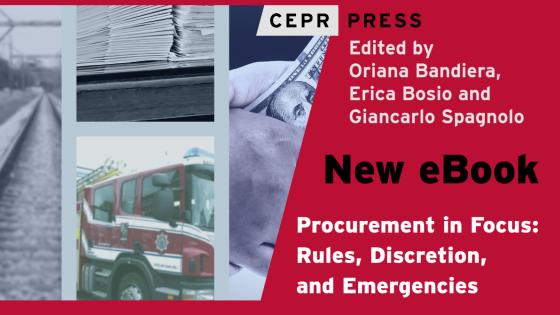Public procurement represents more than 10% of aggregate GDP in the EU. Specific EU Directives define in some detail how government entities must behave when undertaking public procurement that exceeds certain threshold values. The basic principles include competition, non-discrimination, and transparency. Procurement regulation that reflects primarily ‘value for money’ considerations (e.g. Bosio et al. 2020) may skew the allocation of contracts to large firms that are better able to incur the costs associated with procurement processes and satisfy criteria used to ensure bidders have the capacity and track record to implement a contract. Both financial and human resource capacity constraints are likely to be more severe for small and medium-sized enterprises (SMEs) than for large firms, with implications for the capability to incur the (opportunity) costs of dealing with the administrative requirements associated with bidding for public contracts.
Public procurement provisions to facilitate SME participation
SMEs may have limited capacity to satisfy bid security, minimum turnover or experience requirements, difficulties in obtaining loans for the working capital needed to execute a contract on a timely basis, and have less ability to incur the cost of lengthy payment delays that may be associated with public contracts. In response to such constraints, governments tend to take two types of approaches to enhance the participation of SMEs in public procurement (Jehiel and Lamy 2016). The first is through set asides or price-preferences for SMEs. The second is to adopt measures that aim at ‘levelling the playing field’ for SMEs but that apply to all tenders. Examples include simplification of procedures, use of bid eligibility requirements that are not premised on firm size or scale where this is not needed, and encouraging contracts to be split into smaller lots. EU procurement regulation pursues the second type of approach, encouraging procuring entities to: (i) reduce the average size of contracts where possible; (ii) consider sub-division of contracts into smaller lots where this is not detrimental to the realisation of project objectives; and (iii) to ensure timely payments (European Union 2014).
Previous research on the effectiveness of the ‘EU approach’ has had mixed findings. Using data for Spain, Di Giovanni et al. (2022) find that granting procurement contracts to small firms – either by directly targeting smaller firms or by slicing large contracts into smaller ones – help these firms grow and overcome financial constraints. Stake (2017), using Swedish public procurement contract award data, concludes that use of ‘most economically advantageous’ criteria in tender awards rather than lowest price did not increase SME participation and success rates. Glas and Elssig (2018), using contract award data in Germany to assess the effectiveness of splitting tenders into smaller lots, find that this does not significantly increase the success rate of SMEs.
Quality of procurement processes, sub-division of lots, and timeliness of payments
In recent research (Hoekman and Taş 2022), we analyse whether public procurement procedures and measures that aim at enhancing SME participation have the intended effect. We do so by using data on 205,578 public contracts awarded in 32 European countries in 2016 and 2017 sourced from the EU Tenders Electronic Daily (TED) database. TED reports information on all tender opportunities as well as contract awards made by procuring entities in the EU, Iceland, Lichtenstein and Norway, Switzerland, and the Former Yugoslav Republic of Macedonia. We focus on 2016–17 because TED reports information on whether winning firms are SMEs for these years. Our empirical analysis addresses three research questions: (1) the relationship between public procurement regulation and SME participation in tenders, (2) whether better public procurement processes are associated with a higher probability of an SME winning a contract; and (3) whether dividing larger projects (contracts) into smaller lots increases SME participation and their probability of success.
We use two indicators of national public procurement regulation as explanatory variables, controlling for the procurement method used, whether contracts are above the legal value threshold that determines if EU procurement rules apply, and whether a contract is divided into smaller lots. Indicators of the ‘quality’ of procurement regulation prevailing in sample countries are sourced from Djankov et al. (2017) and Digiwhist, a European public sector accountability research initiative.1 Djankov et al. characterise three dimensions of the procurement process: (i) bid preparation; (ii) award procedures; and (iii) payment of suppliers. The first two of these encompass features of the process such as transparency and competition, whereas the payment score is a measure of how burdensome the procedures for request payments are and the average time to process invoices. Digiwhist builds on public accountability indicators to score the quality of national public procurement processes. Both sources reveal substantial cross-country heterogeneity in the ‘quality’ of prevailing public procurement regimes.
Estimation results indicate that countries with better public procurement (higher quality scores) attract significantly more SME bidders and achieve higher levels of competition. Better procurement practices do not favour large firms disproportionately, but larger contract sizes, as expected, are associated with lower participation of SMEs. More surprisingly, we find that SMEs do not tend to benefit from subdivision of contracts into smaller lots. Threshold regression analysis reveals that dividing contracts into smaller lots increases the chances of an SME winning only when the lots are small (for contracts of €25,000 or less). For lots with larger contract values, the analysis finds SMEs are less likely to win public procurement contests even if contracts are subdivided. Finally, we find that procurement regimes that score better on timeliness/ease of payment are positively associated with both SME participation and the probability that a SME wins a contract.
Conclusion
Our results suggest that improving the quality of generally applicable public procurement regulation – reforms towards what are regarded as international good practice – can enhance SME participation in public procurement tenders, while subdivision of lots and lowering contract size may not increase SME win rates unless contracts are very small. The low value of the estimated threshold suggests it is important to minimize the administrative costs associated with participation in public procurement.
References
Bosio, E, S Djankov, E Glaeser and A Shleifer (2020), “Corruption in public procurement”, VoxEU.org, 5 November.
di Giovanni, J, M García-Santana, P Jeenas, E Moral-Benito and J Pijoan-Mas (2022), “Government procurement and macroeconomic outcomes”, VoxEU.org, 15 March.
Djankov, S, T Ghossein, A Islam and F Saliola (2017), “Public procurement regulation and road quality”, World Bank Policy Research Working Paper 8234.
European Union (2014), “Directive 2014/24/EU of the European Parliament and of the Council of 26 February 2014 on public procurement and repealing Directive 2004/18/EC”, Official Journal L94/65.
Glas, A and M Eßig (2018), “Factors that influence the success of small and medium-sized suppliers in public procurement: evidence from a centralized agency in Germany”, Supply Chain Management 23(1): 65-78.
Hoekman, B and B Taş (2022), “Procurement Policy and SME Participation in Public Purchasing”, Small Business Economics 58: 383-402.
Jehiel, P and L Lamy (2016), “Discrimination in public procurements: A cost-reducing guide”, VoxEU.org, 22 November.
Stake, J (2017), “Evaluating quality or lowest price: consequences for small and medium-sized enterprises in public procurement”, Journal of Technology Transfer 42: 1143–1169.
Endnotes
1 Digiwhist is a portmanteau of ‘digital whistleblower’; see http://digiwhist.eu/.



